|
Paper 68
Two Balls from 1806
Contributed by Paul Cooper, Research Editor
[Published - 8th February 2024]
This paper once again continues a theme that we've previously studied in other research papers. Specifically, this paper investigates a pair of historical balls that were held by the British aristocracy near the start of the year 1806. One was hosted by the Duke of Clarence, the other by the Duchess of Devonshire. Both events were held within about a month of each other in London, both would have been attended by only the most elite members of fashionable society. In both cases we will discover a partial list of the country dancing tunes that were enjoyed at the balls, we'll then go on to study those tunes further below.
The tunes and dances that we'll consider further in this paper are:
The Duke of Clarence's Ball
The Duke of Clarence (1765-1837), later King William IV, hosted a Grand Ball on Wednesday 29th of January 1806. It was held at his residence of Bushy House in Teddington, London. The Duke lived there with his mistress, Dorothea Jordan (1761-1816), and their 10 illegitimate FitzClarence children. As the third son of King George III William was not expected to become King. But when his older brother King George IV died in 1830, it was William who took the throne. That was to be far in the future at our 1806 date however, at this time he was one of the Royal Dukes, nominally an Admiral of the Royal Navy (he had been a competent naval officer for many years), also a member of the House of Lords. The Sun newspaper for the 3rd of February 1806 wrote of our Ball (with dance references highlighted in bold):
On Wednesday evening His Royal Highness the Duke of Clarence gave a grand ball and supper, at his seat, Bushy Park, which were attended by above two hundred Nobility, Military and Naval Officers. The Park was lighted, from the Lodge to the entrance; and a party of Spelthorne Legion, which are commanded by His Royal Highness, kept guard. There was a new entrance made to the house, by a descent of several steps, which were covered with matting; all the passages were ornamented with laurel, interspersed with variegated lamps. The grand hall was converted into a saloon, where the company assembled. It was decorated with the finest orange trees, loaded with fruit, and festoons of variegated lamps, the walls covered with the finest paintings, and lighted by three superb Grecian lamps. The ball room was to the left. It was lighted by the finest cut glass chandeliers, and decorated with a collection of the finest paintings of naval exploits.
An Orchestra was prepared for a magnificent Band, which was conducted by the admirable and universally admired Performers, Messrs. Gow. Between the dances, the most favourite Martial Airs were played by the Band of the 14th Light Dragoons. The Ball was opened at nine o'clock, with the favourite dance of The Honey Moon , and was followed by Lady Montgomery , Love and Whisky , the Dusty Miller , Lady Caroline Lee , and Off she goes . Opposite the Grand Saloon was a Card-room, and adjoining it a Corridore, fitted up in the Eastern style, in which there is a window of the finest stained glass, representing some of the most favourite scenes of Shakespeare. It is also decorated with the most beautiful curiosities of the East, and lighted by a Chinese lamp, with transparencies of naval actions. The curtains were of Indian muslin, with draperies of orange satin, most tastefully displayed and festooned.
At half past two the supper-rooms were opened; four tables were laid, two for thirty-four, and two for fourteen. All the ornaments were emblematic of Naval exploits; the supper was hot, and consisted of every delicacy of the season; with the most delicious fruits, and choicest wines. Supper was served on a service of the finest china, a present from Her Majesty to His Royal Highness, and said to have cost eleven hundred guineas. It is most richly gilt, with a medallion on each piece, representing Hope leaning on an anchor, most beautifully executed. At four o'clock dancing recommenced with the favourite dance of Drops of Brandy , Lady Douglas and Sir David Hunter Blair followed. At six o'clock the company that could not be accommodated with beds at Bushy Park, began to disperse, and every person expressed the highest delight at the magnificent entertainment they had partaken of, and the affability and good nature of their Royal Host.
We read that a military band provided musical interludes throughout the ball, whereas the dance music was performed by the Gow band. We've written of the Gow Band elsewhere; this band, presumably led by John Gow (1764-1826) (and potentially also his brother Nathaniel Gow (1763-1832)) had become the foremost dance band in the country. The Gow's provided music for many of the balls held by the aristocracy, they also printed music and acted as an important conduit for dance culture between London and Edinburgh.
Nine country dancing tunes are named as having been danced at this event, we've written about a few of them before: The Honey Moon, Lady Montgomery's Reel, Off She Goes, Drops of Brandy and Sir David Hunter Blair's Reel. We'll investigate the four new tunes further below.
It's perhaps notable to read that while two hundred guests attended, there was only seating capacity at the supper for around half of them. It's also of interest to note that while some of the guests had rooms allocated in the house, most would disperse at around 6am. This seems to have been fairly normal for a grand ball, only a subset of the guests would enjoy the privilege of eating with the host or of sleeping at the venue. Something similar is likely to have been true of the dancing, it's probably the case (based on descriptions of similar balls) that somewhere between twelve and twenty couples would have danced.
The Duchess of Devonshire's Ball
Georgiana Cavendish (1757-1806), the Duchess of Devonshire, hosted a Rout, Supper and Ball on Friday 28th February 1806. She was not well, a mere month later (on the 30th of March 1808) she would die, surrounded by her family, of a lingering illness. The ball would be her last significant social engagement. It was well attended; guests included the Prince of Wales together with one of his Royal brothers, plus a host of dignitaries and notables. The ball may have been hosted to honour her twenty year old daughter Lady Harriet Cavendish (1785-1862) who was reported to have led off the first dance. The Morning Post newspaper for the 1st of March 1806 wrote:
Last night her Grace entertained a large party. The whole suite of magnificent apartments were thrown open at ten o'clock. About eleven the fashionables began to assemble, and soon after twelve o'clock the whole had arrived. The number of card tables were eight. Seven supper tables were set out, on which were arranged every delicacy of the season.
It went on to list an impressive array of guests. The British Press newspaper for the 1st of March 1806 wrote of the event (with dance references in bold):
The Duchess of Devonshire gave her first grand Ball, last evening, at her house, Piccadilly. It was attended by upwards of 300 of the first Nobility. The lower, or servants' hall, was brilliantly lighted by patent lamps; and the staircase leading to the grand hall was covered with scarlet cloth; the grand hall being appropriated for dancing, in it was placed a band of music, under the direction of the Gows. It was brilliantly lighted by magnificent Egyptian lamps, and side patent lamps. At eleven o'clock, the ball was opened by the Hon. Mr Cavendish and Lady Harriet Cavendish, to the favourite air of The Duke of Gordon's Reel. The back and front drawing-rooms were appropriated for supper; and card tables were laid in the middle room. At one o'clock the company sat down to supper;
We read once again that the ever popular Gow band provided the music for this event. Returning to the Morning Post, it published some further information on the 3rd of March 1806 (again with dance references highlighted in bold):
In addition to the account we gave on Saturday last, we have to add, that the dancing commenced about half past eleven o'clock, in the Grand Saloon, which was previously prepared for that purpose. This noble apartment was divested of its usual ornaments, namely, festoons of artificial flowers. Since that room has been modernized, those decorations have been dispensed with. The first dance (The Duke of Perth's Reel) was called for by the accomplished heiress of the house of Drummond. It was led off by Lord Althorpe and Lady Harriet Cavendish; next followed:
Sir John Shelley ... Miss Fordyce
Lord James Murray ... Miss Drummond
Captain Maxwell ... Miss Adam
Captain Macdonald ... Lady Mary Taylor
Lord Alexander Gordon ... Lady Georgiana Cecil
The first set mustered 15 couple. The company exceeding the expectation of the polished hostess, her Grace gave an order for an additional number of supper tables to be set out about one o'clock. The light fantastic toe was exercised more than is usual on such occasions, for previous to supper no less than seven country dances were gone through with great spirit. The supper took place about two o'clock, in the dining-room and the Duchess's dressing-room. At nine tables one hundred and ten persons were accommodated, independently of whom several Gentlemen partook of the entertainment at the side tables standing. The viands and wines were, as usual, of the first description.
Although the supper was so very sumptuous a banquet, the younger branches of the distinguished families present soon quitted the hospitable board for the renewal of the merry dance, in less than half an hour after the entertainment began. The dances which followed in succession were, a Medley, Lady Montgomery, and Lady Mary Bentinck. About half past three o'clock the reels commenced between Mr Thomas Sheridan and Mademoiselle Grammont, Captain Macdonald and Miss St Julie. The Duchess of Gordon, as usual, diffused mirth and hilarity around her. The Duchess of Devonshire never appeared in better health and spirits. The Marquis of Lorne was of the party, but could not be prevailed on to display his great science and taste in reels and strathspeys. The company did not think of departing until half past four in the morning. It was five o'clock before the whole had retired.
Several fascinating details emerge. First we can note that the two newspapers differ over the name of the first dance, one gave it as The Duke of Gordon's Reel , the other as The Duke of Perth's Reel ; either is possible, though I'm rather more inclined to suspect the Duke of Perth's Reel as a tune of that name was popular in 1806. This little disparity offers an important reminder that newspapers can contain errors; if, for example, a tune gets named that is difficult to identify, it's entirely possible that there was an error in the newspaper. We're also informed that the Duchess never appeared in better health and spirits , presumably a polite pleasantry given her serious health problems. We're further informed that the ball started at around 11:30pm, that supper was served at about 2:00am, and that around seven country dances were enjoyed in that time. The average dance took at most 20 minutes to dance through, probably somewhat less time than that. Those seven dances were considered to be more than normal for that duration of time.
One of the named tunes overlaps with that of the Clarence ball above, that being Lady Montgomery, a tune that we've written about before. Towards the close of the ball the dancing turned to Reels, in particular a Reel of Four by two men and two ladies; this is something else that we have written about previously (you might like to follow the link to read more). We'll investiate the two remaining named tunes further below.
Indeed, we will now investigate the various tunes and dances that we've encountered across these two events.
Love and Whiskey / Bobbing Joan
The Ball was opened at nine o'clock, with the favourite dance of The Honey Moon , and was followed by Lady Montgomery , Love and Whisky ... (The Duke of Clarence's Ball)
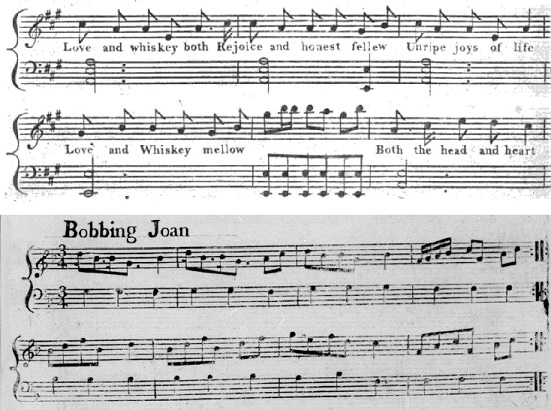
Figure 3. The start of the song Love and Whisky from the 1803 Wife of Two Husbands (upper), and Bobbing Joan from Hime's c.1795 first part of Forty Eight Original Irish Dances (lower)
The first two named tunes from the Duke of Clarence's Ball have been studied in previous papers, whereas the third tune, Love and Whiskey is not one that we've investigated before now. The tune itself is reasonably easy to identify, it was named after a popular song from the 1803 production Wife of Two Husbands (see Figure 3, Upper). This new musical drama was produced at the Theatre Royal, Drury Lane from late October 1803 (The Daily Advertiser, 26th October 1803) with music arranged by Joseph Mazzinghi (1765-1844). The song itself was performed on stage by the Irish actor John Henry Johnstone (1749-1828) in the character of Sergeant Armagh, the score is available here. The Morning Post newspaper for the 3rd of November 1803 commented that Johnstone: introduces the fanciful parallel between love and whiskey. It is unnecessary to say how loudly the following lines were applauded: LOVE and Whiskey can, to any thing persuade us. No other power we fear, That ever can invade us. . The patriotic message of the song being that Britain's armed forces could resist anything at all... except the persuasive powers of love and whiskey! The tune may have become popular in 1803 but it wasn't a new tune, the melody for the song had previously been published under various names, most commonly as Bobbing Joan . References to the tune under this name exist from at least the mid 18th century, it seems to have been a popular Irish tune.
Publications of our tune in dancing arrangements were manifold. The earliest version that I've found in print was issued in Dublin in the first part of Maurice Hime's c.1795 Forty Eight Original Irish Dances under the name Bobbing Joan (see Figure 3, Lower). It would then appear in Edinburgh in Niel Gow's 1802 Part Second of the Complete Repository of Original Scots Tunes, Strathspeys, Jigs and Dances, this time as Bobin John . Thereafter it would appear in a large number of mostly English publications in a variety of arrangements and time signatures; I've found it arranged in 3/4 time, in 3/2 time, in 9/8 time, even as a Quadrille dance in 2/4 measure. The various arrangements are clearly the same tune, yet sufficiently different to add credence to the idea that it was widely known prior to the sudden publication interest. One of the first such publications was that of Dale's c.1805 5th Number under the name Love and whiskey or Bobby Joan ; Dale and his contemporaries were publishing the tune under the now popular name, yet they had also identified the earlier name for the tune. The precise sequence of publication is unknown but further examples include: Walker's c.1805 9th Number (as Bobing Joan ), Campbell's 1806 21st Book (as Bob and John, or Love and Wiskey ), Davie's c.1806 13th Number (as Love and Whisky, or Bobbing Joan ), Skillern & Challoner's c.1806 1st Number (as Love and Whiskey , see Figure 4), James Platts's c.1806 7th Number (as Love and Whiskey ) and in Andrews's c.1810 27th Number (as Love and Whiskey ). It would then reappear in Edinburgh in Robert Petrie's c. 1811 A Fourth Collection of Strathspeys, Reels, Jiggs and Country Dances under the name Bob an' John and back in London in Thomas Wilson's 1816 Companion to the Ball-room as Bobbing Joan, or Love and Whiskey . It was evidently a popular tune.
The story doesn't end there however. Way back in the 1651 first edition of John Playford's Dancing Master a tune named Bobbing Joe was published. This tune remained sufficiently popular to appear in every edition thereafter, well into the 18th century. Various researchers and commentators over the centuries have asserted that Bobbing Joe and Bobbing Joan were the same tune. If that were true, it would offer an almost unique example of a Playford era tune remaining popular into 19th century ballrooms, that in turn would be of significant interest. The thing is, I've compared the tunes and to my mind they're quite different; other than a similarity in name and time signature, they appear quite different to me. I don't know how they came to be conflated. Some early commentators suggest that Playford himself published Bobbing Joe under the name Bobbing Joan in his 1666 Musick's Delight on the Cithren; that isn't so, the copy I've studied clearly shows the name as Bobing Joe . My best guess is that a transcription error at some point in the past caused the two tunes to become incorrectly associated, and therein lies the origin of the confusion. Nonetheless, both tunes will have coexisted for much of the 18th century, our tune may have been named in reference to the Playford tune. It's perhaps of note that the 19th century dance writer Thomas Wilson referred to Bobbing Joe in his 1820 Complete System of English Country Dancing; he dismissed it as being an example of an absurd dance that would be highly inappropriate in a modern ballroom. It seems likely that if he had considered it to be the same tune as the popular Bobbing Joan he'd have mentioned it.
To further complicate matters, another tune named Key of the Cellar or Key to the Cellar appeared in print several times around 1740 (eg in Benjamin Cooke's 24 Country Dances for the Year 1738). Again, some antiquarians have identified it with our Bobbing Joan tune, I myself once again find them to be different tunes.
Returning back to the 19th century, the immediate popularity of our tune in London was clearly related to the 1803 stage production of Wife of Two Husbands. The tune itself probably dates back to at least the mid 18th century and may have been influenced by earlier tunes. It's likely to have been danced at numerous society balls in 1806, our Clarence ball however is the only such event for which I can find definitive evidence at around our date. It was enjoyed at a gala at Margate's Dandelion Gardens in 1805; the Courier newspaper for the 9th of August 1805 wrote: ... the Master of the Ceremonies, Mr Le Bas, waved his sceptre, as the signal for mounting the platform and beginning the merry rout. The Band instantly struck up a lilt, by way of a preparation, which was followed by the favourite tune of Love and Whiskey, to which a throng of all descriptions beat time with great frolic and vivacity. . This event is curious for describing what seems to have been unstructured general dancing. The tune was also danced at an event of 1823 celebrating the birthday of a Mr Limbrick (Bell's Life in London, 8th of June 1823); this event is curious for having featured several tunes from our 1806 Clarence ball, it's possible that the host was deliberately recreating the event that we're studying.
We've animated a suggested arrangement of Skillern & Challoner's c.1806 version (see Figure 4).
For further references to the tune, see also: Love & Whiskey or Bob & Joan at The Traditional Tune Archive.
Dusty Miller
The Ball was opened at nine o'clock, with the favourite dance of The Honey Moon , and was followed by Lady Montgomery , Love and Whisky , The Dusty Miller ... (The Duke of Clarence's Ball)

Figure 5. Dusty Miller from John Walsh's c.1735 Thirty New and Choice Country Dances (left) and from Thomas Wilson's 1816 Companion to the Ballroom (right).
The next tune from out Clarence ball was named Dusty Miller . The title probably relates to the inherently dusty operation of milling flour, though it could potentially allude to a dusty looking plant of the same name. The tune itself is easily identified, it was printed many times across the 18th century and into the 19th century. It was a veteran and popular tune.
The first publication of the tune that I've been able to identify was issued in London within John Walsh's c.1735 Thirty New and Choice Country Dances (see Figure 5, left). I'm informed that it appears in even earlier Walsh dance collections back to around 1718, it certainly reappeared in his c.1736 first volume of Caledonian Country Dances. It then resurfaced in several further London dance publications of the 1740s, examples include Johnson's c. 1740 first volume of A Choice Collection of 200 Favourite Country Dances, Wright's c.1740 Compleat Collection of Celebrated Country Dances, and Johnson's c.1748 Caledonian Country Dances. It was issued again in the c.1758 4th part of Robert Bremner's A Collection of Scots Reels or Country Dances, in the c.1764 Second volume of Thompson's Compleat Collection of 200 Favourite Country Dances and in Dublin in Maurice Hime's c.1795 Forty Eight Original Irish Dances. Shortly thereafter it appeared in a flurry of London publications including: Longman & Broderip's c.1795 Fifth Selection of the most admired Dances, Reels, Minuets & Cotillons, Campbell's c.1796 11th Book, Bland & Weller's 24 Country Dances for 1797, Preston's 24 Country Dances for 1797, Thompson's 24 Country Dances for 1798, Preston's c.1798 Book 5, Selection of the most favorite Country-Dances, Reels &c. and Rolfe's 24 Country Dances for 1799. Moving forward into the 19th century, it appeared in Davie's the c.1803 6th Number and in James Platts's c.1807 2nd Number. It was referenced by Thomas Wilson in his 1809 Treasures of Terpsichore, by Edward Payne in his 1814 New Companion to the Ballroom and once again in 1816 in Thomas Wilson's Companion to the Ballroom (see Figure 5, right).
It was also being danced to. For example, a ball hosted by the Lady Mayoress was opened with The Dusty Miller in 1801 (Kentish Gazette, 10th of April 1801). A stage performer named Master Byrne danced a solo to the tune at Drury Lane in 1804 (Morning Post, 5th of January 1804) as part of a production of Cinderella. It was also mentioned as having been played at an Inn in Congleton in 1811 (Chester Chronicle, 13th of September 1811), and at the Limbrick ball of 1823 (Bell's Life in London, 8th of June 1823).
Some of the sources refer to the tune as being of English origin, others as Scottish, others still as Irish. It was evidently an old and widely known tune at our date of 1806, though the origins of the tune are lost.
We've animated a suggested arrangement of Thomas Wilson's 1816 version of the dance (see Figure 5, right).
For further references to the tune, see also: Dusty Miller (6) (Old) at The Traditional Tune Archive.
Lady Caroline Lee's Waltz / Gloucester Waltz / Lady Harriet Lee's Waltz
The Ball was opened at nine o'clock, with the favourite dance of The Honey Moon , and was followed by Lady Montgomery , Love and Whisky , The Dusty Miller , Lady Caroline Lee ... (The Duke of Clarence's Ball)
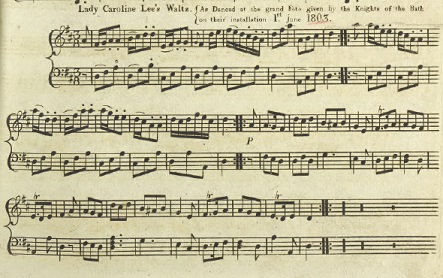
Figure 6. Lady Caroline Lee's Waltz from John Bowie's c.1803 Four new Tunes.
The next tune that we'll investigate from the Duke of Clarence's ball was named Lady Caroline Lee's Waltz. The tune is easy to identify as it was widely published. There is however a mystery over who the tune was named for. Before we consider that uncertainty it's useful to know that there are two further names by which the tune is known: Gloucester Waltz and Lady Harriet Lee's Waltz. All three names were used concurrently, though the given name of Lady Caroline Lee's Waltz was by far the most common.
The first of our candidate dedicatees is Lady Caroline Leigh (1729-1804). She was the daughter of the Duke of Chandos. She is the only candidate I can find who genuinely held the title of Lady . She was not a young lady however and would have been an unexpected and unusual dedicatee for (what would become) a popular Waltz tune. Tunes were usually named for young fashionables. She was however from Gloucestershire, which might offer a reason for one of the alternative names of the tune being in circulation. Our next candidate was the granddaughter of the first candidate, Caroline Eliza Leigh (1794-1870). She was quite young to have been the dedicatee of our tune, though child dedications were not uncommon so she is definitely a viable possibility. A tune could perhaps have been named for the young Caroline to curry favour with the older Caroline. Other less viable candidates include Caroline Louisa Lee (c.1789-1866) who would go on to receive the title Lady upon her marriage to Viscount Ranelagh in 1811; the problem with her candidacy is that her surname changed at the same time and that this would be a future event at the date at which the tune circulated. A further candidate might be one of the daughters of Egerton Leigh (1752-1833) who included both a Caroline Leigh and a Harriet Leigh (which matches one of the alternative names for the tune); neither had a claim to the title Lady however. A further possibility is that the tune was named for an unidentified member of the Baronet Lees of Hartwell family, or of the Lockharts of Lee family, or indeed of some other aristocratic family. Or the name may refer to someone else entirely, perhaps even a character from a play or other stage performance. The source of the name remains uncertain.
As far as I can discern the tune first emerged in 1803. It was published approximately concurrently in both Edinburgh and London under two different names. John Bowie published it in Edinburgh in his c.1803 Four new Tunes publication as Lady Caroline Lee's Waltz (see Figure 6), John Davies published in in London in his c.1803 8th Number as the Glo'ster waltz . It was also published in London in Goulding's c.1803 5th Number as Lady Caroline Lee's Waltz . It's not possible to determine which of these three came first. The Bowie publication is especially interesting as he added the following comment: As Danced at the grand Fete given by the Knights of the Bath on their installation 1st June 1803 . The Fete referenced was held at Ranelagh Gardens in London, the General Evening Post for the 2nd of June 1803 reported that a supper was served for 2000 persons, that 40000 lamps were used, that a large temporary Rotunda was constructed in the park and that both the King and the Prince of Wales were present for the event. It's possible that our tune was composed specifically for this event; if so, it would certainly have been debuted to a large and influential audience.
It was widely published in the years thereafter. Examples include Campbell's c.1804 19th Book, Hodsoll's Collection of the Most Fashionable Country Dances for the Year 1805, Cahusac's collection of 12 for 1805, Dale's c.1805 5th Number, Andrews's c.1805 8th Number and Goulding's collection of 24 for 1805; in each case the title was some variation of Lady Caroline Lee's Waltz . It was also published in Walker's c.1806 11th Number and in Broderip & Wilkinson's 1806 Selection of the most Admired Dances, Reels, Waltz's, Strathspeys & Cotillons. It was published in Button & Whitaker's c.1806 1st Number under the new name of Lady Harriet Lee's Waltz , and again in John Paine's 24 for 1807 under the same name. It would also be published under this variant name in Liverpool in Hime's c.1812 10th Number. It was published in Edinburgh at an uncertain date in Nathaniel Gow's c.1808 Mr Frank Walker's Strathspey publication back under the more common name of Lady Caroline Lee's Waltz , then in London in James Platts's 1809 11th Number (see Figure 7) and in Davie's c.1809 22nd Number. It was included in Monzani's c.1810 12th Number, it was also referenced in Thomas Wilson's 1809 Treasures of Terpsichore and in Edward Payne's 1814 New Companion to the Ballroom. It was clearly a popular tune.
It was also being danced at society balls, indeed we've already discovered that it was danced in June of 1803 at an event held in London by the Knights of the Bath. It would also be danced in Margate in 1803 at a ball held by the Master of the Ceremonies there (Morning Post, 7th of October 1803), it was reported that The country dances commenced soon after ten, with the favourite waltz called, Lady Caroline Lee, by the Countess of Pomfret and Captain Broadhurst. Two sets were formed at the beginning of the evening; but, before 12 o'clock, no less than five sets danced. . It was also danced the following year at the Lincoln Races ball (British Press, 24th of September 1804), and in 1805 at Brighton Castle (The Sun, 14th of August 1805) where the merry dance, in two sets, commenced with the fashionable air of Lady Caroline Lee's Waltz; about 50 couple standing up, and engaging in the graceful exercise with suitable vivacity and spirit. . It would be danced in Brighton Castle once again (Morning Herald, 3rd of October 1805) shortly thereafter, though this time the name of the tune was incorrectly given as Lady Caroline Lee's Reel. It was danced at our Clarence ball of late January 1806, at Lady Vernon's Ball in April 1806 (Morning Herald, 12th of April 1806), also at a ball held in Aldborough (Morning Post, 6th of September 1806). It was also advertised to have been encoded onto the barrel of an organ in 1808 (Coventry Herald, 2nd of December 1808). It was evidently a popular tune for several years of the first decade of the 19th century.
We've animated a suggested arrangement of Cahusac's 1805 version of the dance and also of James Platts's 1809 version of the dance (see Figure 7).
For further references to the tune, see also: Lady Caroline Lee's Waltz at The Traditional Tune Archive.
Miss Mary Douglas's Reel / Lady Mary Douglas's Reel / Newcastle Volunteers Quick Step
At four o'clock dancing recommenced with the favourite dance of Drops of Brandy , Lady Douglas ... (The Duke of Clarence's Ball)

Figure 8. Newcastle Volunteers Quick Step from Thomas Calvert's c.1799 A Collection of Marches & Quick Steps, Strathspeys & Reels.
Our final tune from the Duke of Clarence's Ball was named as Lady Douglas . This tune is relatively simple to identify as it was heavily published in London between about 1803 and 1807, typically under the name Lady Mary Douglas's Reel or a variation of that name. The publication history is a bit more complicated however. Many other tunes have been published over the years with similar names that could theoretically have been used at our ball, most of them have no credible claim to having been danced.
Before investigating the most probable tune, let's first consider a different tune that was published in Edinburgh by Niel Gow in his c.1788 Second Collection of Strathspey Reels &c. under the name Miss Mary Douglass's Reel . This tune has a similar name to the tune that we're interested in and was credited to the composition of a James Macdonald. Shortly thereafter it would be published in London in the c.1789 Caledonian Muse publication from the Thompson family under the same name. Some years later it would be republished in London by the Cahusac family in their collection of 24 Country Dances for 1804. The Cahusac's most likely republished it in the belief that it was the tune that was proving popular at society balls around that date, if so they were mistaken, but it's a notably related tune and may have been dedicated to the same person as our tune.
The tune that almost certainly was danced at our ball was first published in Edinburgh from around the year 1799 in Thomas Calvert's c.1799 A Collection of Marches & Quick Steps, Strathspeys & Reels under the name Newcastle Volunteers Quick Step (see Figure 8). This title suggests that it was a marching tune associated with a Regiment of soldiers from Newcastle in the north of England. Approximately a year later it would be republished in Edinburgh by Nathaniel Gow in his c.1800 Miss Sitwell's Strathspey publication under the new name of Miss Mary Douglass (note that Gow named it for a Miss Douglas rather than a Lady Douglas ); Gow went further and explained that the tune was performed by the Royal Edinr Volunteers , once again indicating it to be a Regimental marching tune. A little later still it would reappear in London in Robert Mackintosh's c.1803 A Fourth Book of New Strathspey Reels under the name Miss Mary Douglas's favorite with the additional annotation that it was by T. Wright , someone I've not been able to identify. The implication from across these early publications is that the tune may have been first associated with either or both of the Newcastle Volunteers and the Royal Edinburgh Volunteers , then became associated with a Miss Mary Douglas , perhaps after she called for the tune at a Ball. The subsequent publications of the tune in London almost always give the title as Lady Mary Douglas . This Lady Douglas may or may not have been the same person as Miss Douglas but it's by this name that the tune would be widely published in London.
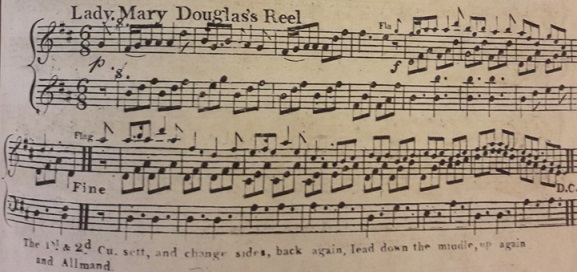
Figure 9. Lady Mary Douglas's Reel from Wheatstone & Voigt's c.1806 1st Book.
The London publications of the tune thereafter are many, the precise sequence of publication is uncertain but examples include: William Campbell's c.1803 18th Book, Goulding's c.1803 3rd Number (once again under the name The Newcastle Volunteers ), Goulding's 24 for 1804 (reverting back to Lady Mary Douglas), Dale's c.1804 4th Number, Hodsoll's collection for 1805, Andrews's c.1805 8th Number, Walker's c.1806 11th Number, Napier's c.1806 Selection of Dances & Strathspeys, Button & Whitaker's c.1806 3rd Number and in Wheatstone & Voigt's c.1806 1st Book (see Figure 9). It would also be referenced in Thomas Wilson's 1809 Treasures of Terpsichore and be published within his 1816 Companion to the Ballroom.
The London based publishers almost invariably used the name Lady Mary Douglas (or some variation thereof). In so doing, they explicitly associated the tune with a real person named Lady Mary Douglas (d.1841). She was the oldest daughter of Sir William Douglas (c.1730-1783) and married Thomas Sydney Beckwith (1770-1831) in 1817. It's entirely possible that this association was accidental, if it was originally associated with a Miss Mary Douglas then the original dedicatee is forgotten. The tune may genuinely have been composed by a T. Wright and have circulated in the north of England and south of Scotland for a few years before being published.
Our tune was also danced at various society balls. Examples include the Mrs Eiliker's and the Ladies Townshends Ball of 1803 (Morning Post, 4th of June 1803) where it was danced under the name Miss Mary Douglas , at a Brighton Ball of 1804 (The Sun, 3rd of January 1804) where it was danced as Lady Douglas , at a second Brighton Ball of 1804 (Morning Herald, 30th of April 1804) as Lady Mary Douglas , at Mrs Creeway's Ball of 1804 (Morning Post, 14th of June 1804) as Miss Mary Douglas and at a Dublin Castle ball of 1810 (The Sun, 20th of January 1810) as Lady Mary Douglas .
We've animated a suggested arrangement of Wheatstone & Voigt's c.1806 version of the dance (see Figure 9) and of Campbell's c.1803 version.
For further references to the tune, see also: Lady Mary Douglas at The Traditional Tune Archive.
Duke of Gordon's Birth Day / Duke of Gordon's Reel
At eleven o'clock, the ball was opened by the Hon. Mr Cavendish and Lady Harriet Cavendish, to the favourite air of The Duke of Gordon's Reel. (The Duchess of Devonshire's Ball)
The first tune that we'll investigate from the Duchess of Devonshire's ball was named as The Duke of Gordon's Reel . At the outset we should acknowledge that there's no certainty that this tune was actually danced at the ball, we have two conflicting accounts of that first dance, one of which names it as Duke of Gordon's Reel and the other as Duke of Perth's Reel , presumably at least one of the reporters was confused. Nonetheless, we'll continue by assuming that the name of the tune is correct. In which case, this is an interesting title as there were in fact several tunes published under the name Duke of Gordon's Reel (or a minor variation of it) in circulation, none of them have any real claim to being a favourite air however. Most such tunes were relatively obscure. Whereas there was another tune named The Duke of Gordon's Birth Day which was very popular around the start of the 19th century, it therefore seems likely that the tune danced at our ball was this widely published tune. Indeed, one of the London publishers (Cahusac in their collection of 24 Country Dances for 1794, see Figure 10, right) actually issued The Duke of Gordon's Birth Day under the name Duke of Gordon's Reel , which is evidence that our popular tune was circulating under both titles.
The title of the tune does of course refer to Alexander Gordon (1743-1827), the Duke of Gordon. It's unclear at what date the tune was composed but it's likely that it genuinely was used at a celebration of the Duke's birthday.
The first publication of our tune that I've been able to identify was in Edinburgh in Alexander McGlashan's c.1786 A Collection of Reels. This publication is interesting as McGlashan identified the composer as being William Marshall (1748-1833). Marshall genuinely did compose this tune and published it in his c.1822 Scottish Airs, Melodies, Strathspeys, Reels, &c. much later in life, I've not found the tune in any of his earlier works however. The tune may have been unpublished prior to McGlashan issuing it. I do however note that another tune named The Duke of Gordon's Reel was included in Marshall's 1781 A Collection of Strathspey Reels; this earlier tune is somewhat similar to our The Duke of Gordon's Birth Day but it is a different tune. Nonetheless, it's possible that the two tunes were confused with each other from an early date.
As we've seen, our tune was published by Alexander McGlashan in Edinburgh c.1786 as The Duke of Gordon's Birth day . It was then republished in Edinburgh in Joshua Campbell's c.1789 A Collection of New Reels & Highland Strathspeys and in John Anderson's c.1789 A Selection of the most Approved Highland Strathspeys, Country Dances, English & French Dances. Publication would then move to London when it appeared in William Campbell's collection of 24 Country Dances for 1790, in Longman & Broderip's Eighteen of the Newest and most favorite Country Dances for the year 1791, then in William Campbell's c.1792 7th Book (see Figure 10, left). After that it would appear in London in the previously mentioned Cahusac collection of 24 Country Dances for 1794 where it was titled as Duke of Gordon's Reel (see Figure 10, right). Publication next moved to Glasgow where the tune appeared in the 1794 4th volume of Aird's A Selection of Scotch, English, Irish and Foreign Airs, then returned to London in the Thompson's collection of 24 Country Dances for 1795 under the slightly different title of The Duke of Gordon's Birth Day Ball . Back in Edinburgh the tune was published in Neil Gow's 1799 Part First of the Complete Repository of Original Scots Slow Strathspeys and Dances, once again a composition credit was offered to by Gow to Mr Marshall . Back in London it appeared in Smart's c.1800 Collection of New & Favorite Country Dances, Waltz's & Reels, in Davie's c.1802 5th Number and in Goulding's c. 1803 4th Number. The tune was also named in Edward Payne's 1814 Companion to the Ballroom. Our tune was popular, but perhaps a little old fashioned by the 1806 date of the Devonshire Ball.
We've animated a suggested arrangement of Campbell's c.1792 version of the dance (see Figure 10, left) and of Smart's c.1800 version.
For further references to the tune, see also: The Duke of Gordon's Birth Day at The Traditional Tune Archive.
Duke of Perth's Reel / Lord Rockingham's Reel / Scampton Cade
The first dance (The Duke of Perth's Reel ) was called for by the accomplished heiress of the house of Drummond. (The Duchess of Devonshire's Ball)
The next tune that we'll investigate from the Duchess of Devonshire's ball was named as The Duke of Perth's Reel . Once again we must acknowledge that this tune may have been misnamed in the newspaper, we have two conflicting accounts of the first dance one of which names it as Duke of Gordon's Reel and the other as Duke of Perth's Reel . Presumably at least one of the accounts is mistaken. Nonetheless, we'll continue by assuming that the name of the tune is correct.
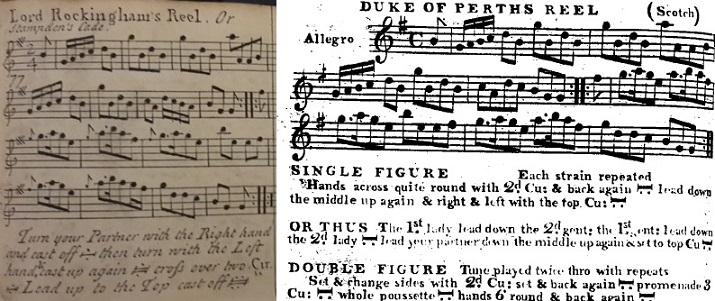
Figure 11. Lord Rockingham's Reel, or Scampden's Cade from Johnson's c.1758 8th volume of Two Hundred Favourite Country Dances (left); and Duke of Perths Reel from Thomas Wilson's 1816 Companion to the Ballroom (right).
A tune of this name was relatively well known, especially in Scotland. The first publication of the tune that I can identify was actually issued in London by Robert Bremner in the c.1757 first part of his A Collection of Scots Reels or Country Dances, Bremner published it as Duke of Perth's Reel . It would reappear shortly thereafter under a different name in Johnson's c.1758 8th volume of Two Hundred Favourite Country Dances (see Figure 11, left), Johnson published it as Lord Rockingham's Reel, or Scampden's Cade . The tune was already known by several different names at this early date. It would appear once again in London in Rutherford's second volume of the Compleat Collection of 200 of the most celebrated Country Dances perhaps around 1764 as Scampton Cade , though Rutherford is likely to have first published it in an annual volume issued around 1759. These three competing names for the same tune at around the same date suggest that it may have been in circulation for quite some time before having been printed.
Moving forward, it was published in Edinburgh in Neil Stewart's c.1761 A Collection of the Newest and Best Reels or Country Dances, then in Glasgow in the c.1783 second volume of Aird's Selection of Scotch, English, Irish and Foreign Airs, and again in Edinburgh in Robert Petrie's c.1796 A Second Collection of Strathspey Reels &c.. It would also be published in Edinburgh by Niel Gow in his 1802 Part Second of the Complete Repository of Original Scots Tunes, Strathspeys, Jigs and Dances. In each case the tune was issued as Duke of Perth's Reel. It would also be issued in London multiple times... or at least tunes of the same name would be, I've not been able to access copies of the following works to confirm that it really was the same tune being published; with that proviso, London examples include: Longman & Broderip's c.1786 Sixth Selection of the most admired Dances, Reels, Minuets & Cotillons, Bland & Weller's collection of 24 Country Dances for 1800 and Dale's c.1806 7th Number. What I can confirm is that the tune was also published in Thomas Wilson's 1816 Companion to the Ballroom as Duke of Perth's Reel (see Figure 11, right). The tune was evidently still known in Regency London, it could have been danced at our ball of 1806.
It's uncertain which Duke of Perth the tune was named in reference to. If the tune first came into circulation in 1757 then it could have been named for Edward Drummond (d.1760) the 6th Duke who received the title that year; it could however have been named for one of his predecessors, depending on when the tune first started to circulate.
We've animated a suggested arrangement of Thomas Wilson's 1816 version of the dance.
For further references to the tune, see also: Duke of Perth's Reel at The Traditional Tune Archive.
Miss Bentick's Fancy / Lady Mary Bentincks Fancy / Le deroutte de Palatines
The dances which followed in succession were, a Medley, Lady Montgomery, and Lady Mary Bentinck. (The Duchess of Devonshire's Ball)
The final tune that we'll investigate in this paper was one half of a medley (a combination of two tunes) and was named as Lady Mary Bentinck . This tune had been popular across the 1790s and into the 1800s, it is therefore fairly easy to identify.
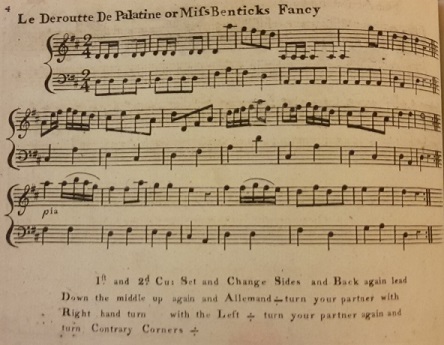
Figure 12. Le Deroutte De Palatine or Miss Benticks Fancy from William Campbell's c.1791 6th Book
The first publication of the tune that I can identify was issued in London as part of Thomas Budd's 1791 21st Book where it was named Le deroutte de Palatines. At around the same date it was also published by William Campbell in his c.1791 6th Book as Le Deroutte De Palatine or Miss Benticks Fancy (see Figure 12). It's not clear why the name of the tune changed but it's perhaps notable that the new dedicatee was addressed as Miss rather than Lady , she was also named as Bentick rather than Bentinck . We'll return to consider this point further shortly. One further 1791 source for the dance is the Princess Frederica Fan printed for the year 1792. Following this c.1791 debut the tune would reappear multiple times under the new name; examples include the Cahusac collection of 12 Country Dances for 1792 and in Preston's c.1794 Selection of the most favorite Country-Dances, Reels, &c., in both cases under the name Miss Bentick's Fancy . It would also be published in Glasgow in the c.1798 6th volume of Aird's Scotch, English, Irish and Foreign Airs as Miss Beutick's Fancy (presumably a corruption of the earlier title). Thus far the title has generally referred to a Miss Bentick , her identity is otherwise unknowable.
That title would change in the early 19th century, perhaps beginning with William Campbell in his c.1805 20th Book. Despite having previously issued the tune in his c.1791 6th Book he now reissued it under the new name of Lady Mary Bentincks Fancy . The new dedicatee is readily identified as Lady Mary Cavendish-Bentinck (1762-1835), the youngest daughter of the Duke of Portland. It's possible that this same lady had always been intended to be the dedicatee of the tune; it's also possible that Campbell, or his source, confused the name of the tune, perhaps assuming that it must have been named for the celebrated socialite. However it came to be, the tune was usually printed under this new name thereafter. Examples of publication under the new name include James Platts in his c.1807 1st Number, Dale's c.1808 12th Number, Button & Whitaker's c.1808 8th Number and Monzani's c.1809 10th Number. The tune would also be referenced in Edward Payne's 1814 A New Companion to the Ballroom as Lady Mary Bentick and by Thomas Wilson in his 1816 Companion to the Ballroom as Miss Bentick's Fancy (reverting back to an older name in the process). The tune was also published c.1805 in Goulding's 5th Number under the incorrect name of Lady Charlotte Benticks Fancy ; another popular tune was in circulation at that time which was genuinely dedicated to Lady Charlotte Bentinck (c.1773-1862, Mary's older sister), it's likely that Goulding & Co got confused by the similarly named tunes. One further tune of note was published c.1811 by James Platts in his 25th Number, this time named Lady Mary Bentinck's Return ; this was a new tune yet was closely derived from the earlier tune, our tune clearly remained of interest into the new decade.
Returning back to the subject of Lady Mary Bentinck herself, she may have played an important role in the history of English social dance. The Morning Post newspaper for the 25th of March 1801 reported that Lady Mary Bentinck gave a ball on Thursday evening, at Portland House, to a select circle of friends, for the purpose of introducing a new and beautiful dance . We're not told what this new dance was but it's not difficult to guess; another socialite, Maria Hester Park, published her A Waltz composition in 1801 dedicated to Lady Mary (Monthly Magazine, July 1801). It's very likely that Lady Mary Bentinck and her circle of friends were dancing the couple waltz back in 1801. In so doing they may have planted some of the initial seeds for the dance revolution that would follow in the mid 1810s. They wouldn't have been the only socialites to be waltzing of course, they were just (potentially) part of the first wave. You can read more about the early history of the waltz dance in England in our paper on the subject.
We've animated a suggested arrangement of Campbell's c.1791 version (see Figure 11) version of the dance, of James Platts's c.1807 version and of Button & Whitaker's c.1808 version.
For further references to the tune, see also: Miss Bentick's Fancy at The Traditional Tune Archive.
Conclusion
In this paper we've studied two balls that were held in early 1806, along with the tunes that are understood to have been dance to at the balls. The Devonshire ball is particularly interesting for providing the information that seven country dances were enjoyed before supper, and that this was an uncommonly high number. We can infer that most balls would involve fewer dances prior to the meal. Most of the tunes that we've encountered are readily identifiable, though with the proviso that they were published under multiple names. Several of them were veteran tunes that had been known for many decades prior to the date of the balls.
But it's at this point that we'll end the investigation. If you'd like to hold a ball themed around the year 1806 then the tunes investigated here would be very suitable choices for your event. If you have any additional information to share, do please Contact Us as we'd love to know more.
|


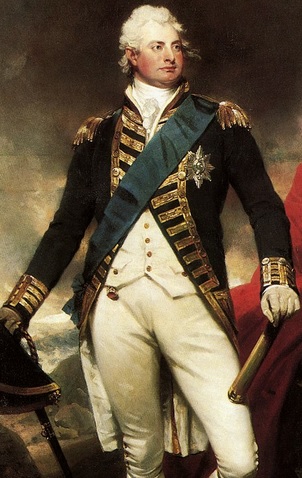 Figure 1. The Duke of Clarence c.1800, Image courtesy of Wikimedia Commons
Figure 1. The Duke of Clarence c.1800, Image courtesy of Wikimedia Commons
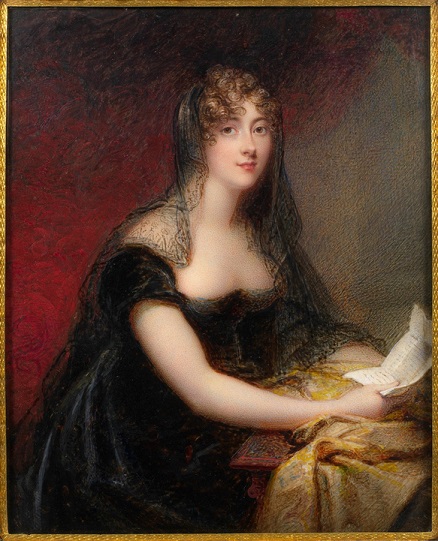 Figure 2. Georgiana, Duchess of Devonshire depicted c.1800. Image courtesy of the Royal Collection Trust.
Figure 2. Georgiana, Duchess of Devonshire depicted c.1800. Image courtesy of the Royal Collection Trust.
 Figure 3. The start of the song Love and Whisky from the 1803 Wife of Two Husbands (upper), and
Figure 3. The start of the song Love and Whisky from the 1803 Wife of Two Husbands (upper), and 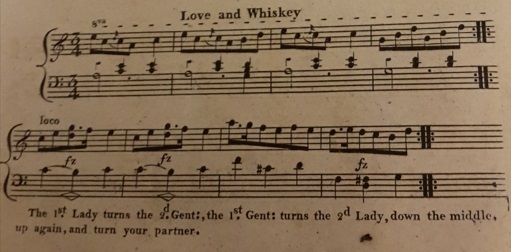 Figure 4. Love and Whiskey from Skillern & Challoner's c.1806 1st Number
Figure 4. Love and Whiskey from Skillern & Challoner's c.1806 1st Number
 Figure 5. Dusty Miller from John Walsh's c.1735 Thirty New and Choice Country Dances (left) and from Thomas Wilson's 1816 Companion to the Ballroom (right).
Figure 5. Dusty Miller from John Walsh's c.1735 Thirty New and Choice Country Dances (left) and from Thomas Wilson's 1816 Companion to the Ballroom (right).
 Figure 6. Lady Caroline Lee's Waltz from John Bowie's c.1803 Four new Tunes.
Figure 6. Lady Caroline Lee's Waltz from John Bowie's c.1803 Four new Tunes.
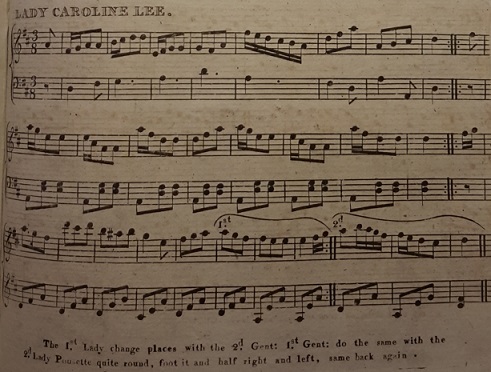 Figure 7. Lady Caroline Lee from James Platts's 1809 11th Number.
Figure 7. Lady Caroline Lee from James Platts's 1809 11th Number.
 Figure 8. Newcastle Volunteers Quick Step from Thomas Calvert's c.1799 A Collection of Marches & Quick Steps, Strathspeys & Reels.
Figure 8. Newcastle Volunteers Quick Step from Thomas Calvert's c.1799 A Collection of Marches & Quick Steps, Strathspeys & Reels.
 Figure 9. Lady Mary Douglas's Reel from Wheatstone & Voigt's c.1806 1st Book.
Figure 9. Lady Mary Douglas's Reel from Wheatstone & Voigt's c.1806 1st Book.
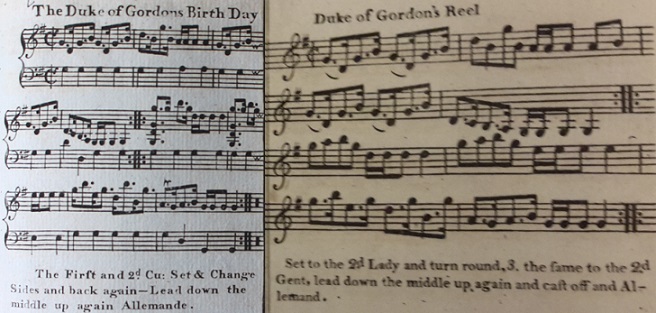 Figure 10. The Duke of Gordons Birth Day from William Campbell's c.1792 7th Book (left) and Duke of Gordon's Reel from the Cahusac collection of 24 Country Dances for 1794 (right).
Figure 10. The Duke of Gordons Birth Day from William Campbell's c.1792 7th Book (left) and Duke of Gordon's Reel from the Cahusac collection of 24 Country Dances for 1794 (right).
 Figure 11. Lord Rockingham's Reel, or Scampden's Cade from Johnson's c.1758 8th volume of Two Hundred Favourite Country Dances (left); and Duke of Perths Reel from Thomas Wilson's 1816 Companion to the Ballroom (right).
Figure 11. Lord Rockingham's Reel, or Scampden's Cade from Johnson's c.1758 8th volume of Two Hundred Favourite Country Dances (left); and Duke of Perths Reel from Thomas Wilson's 1816 Companion to the Ballroom (right).
 Figure 12. Le Deroutte De Palatine or Miss Benticks Fancy from William Campbell's c.1791 6th Book
Figure 12. Le Deroutte De Palatine or Miss Benticks Fancy from William Campbell's c.1791 6th Book